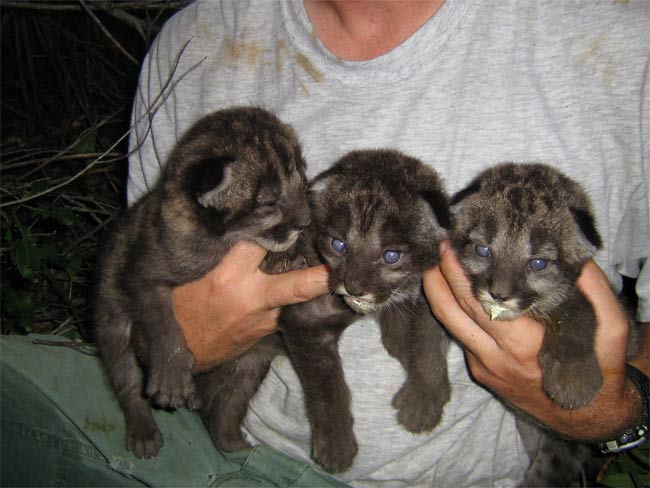
Texas Cats Give Florida Panthers Another 9 Lives

On the verge of extinction less than two decades ago, the Florida panther has regained strength and numbers with the help of some big Texan cats, according to new research.
An estimated three times as many panthers are now slinking through the swamps and Everglades of southern Florida compared withthe mid-1990s, when just 20 to 30 were thought to remain.
"The population today, achieved through genetic restoration, is healthier and larger as a result of mimicking a process that historically occurred naturally between Florida panthers and Texas pumas," noted David Onorato of the Florida Fish and Wildlife Conservation Commission and one of the researchers on the study. (Panthers are also called pumas, cougars and mountain lions.)
After dramatic habitat reduction and hunting in the late 1800s and throughout the 20th century, Florida panther populations eventually plummeted to the point where so few of the cats existed that inbreeding followed. Serious genetic-related health problems ensued, including heart defects, poor-quality sperm and undescended testes, as well as a few innocuous anomalies such as cowlicks and kinked tails.
The last surviving panther subspecies in Eastern North America was caught in a downward spiral. All bets were on the cat to go extinct—and quickly. "This put us in a bit of a pickle," said Stephen O'Brien of the National Cancer Institute, in Maryland, and senior researcher on the study.
Bring in the big cats
In 1995, researchers decided on a bold strategy. They would bring in eight females from a Texas population that once shared the Florida panthers' gene pool, but could no longer make it past the freeways of Jackson, Mobile and Gainesville to mate. Then they would watch and wait.
Sign up for the Live Science daily newsletter now
Get the world’s most fascinating discoveries delivered straight to your inbox.
It appeared to work. "Thanks to this healthy infusion of fresh genetic material, the next generation didn't suffer the same problems that their parents did," said Craig Packer of the University of Minnesota, who was not involved with the study but wrote an accompanying commentary on it for the journal Science.
However, Packer added, no one can be entirely sure if the population boost was solely due to this improved genetic vigor. While the Florida and Texas cats were mingling, for example, more habitat was opening up due to a variety of conservation measures, and wildlife underpasses were being constructed to reduce the risk of vehicle strikes.
Regardless, the cats were obviously healthier, as evidenced by their improved ability to climb trees when pursued by scientists, and through data from the rigorous genetic and physical evaluations researchers had carried out on nearly 600 cats starting back in the late 1970s.
"We know who everyone's father is," O'Brien said. "We know their offspring, genetic heritage, clinical condition, who survived and who didn't. All these things were not guesswork."
Panthers' endangered pals
The new study's landmark methods and findings offer encouragement for other endangered animals that are clawing at survival. Reintroductions are either underway or being considered for the restoration of lion and rhinoceros populations in Africa and a leopard species in Russia.
Meanwhile, the challenges are only going to get tougher for the American cats, suggested Packer. "At the same time that they were relocating cougars from Texas to Florida, the state of Montana had raised its hunting quotas on the cats to a phenomenally high level," he said.
Montana isn't alone. A number of Western states continually attempt to reduce their carnivore populations, typically out of concern over the risks they pose to people, pets and livestock.
"And as our housing developments and ranches spread more and more into wildlife areas, big cats are inevitably going to be restricted to small island populations just like the Florida panther," Packer said. "If there is going to be the continuation of healthy populations of tigers, leopards, lions and jaguars, it's going to require an awful lot of management."
Of course, Florida is still far from a safe cat haven. Panthers have nearly saturated the available habitat, noted O'Brien, and the current 100 or so adult panthers remain just a fraction of the number needed for a sustainable population.
"There's still not much of a way that a cougar from Montana or Texas is going to make it past Knoxville and Little Rock," Packer said. "So this may have to be repeated sometime in the future."
The study is detailed in the Sept.23 edition of the journal Science.
- 10 Species Success Stories
- 10 Species You Can Kiss Goodbye
- World's Cutest Baby Wild Animals









